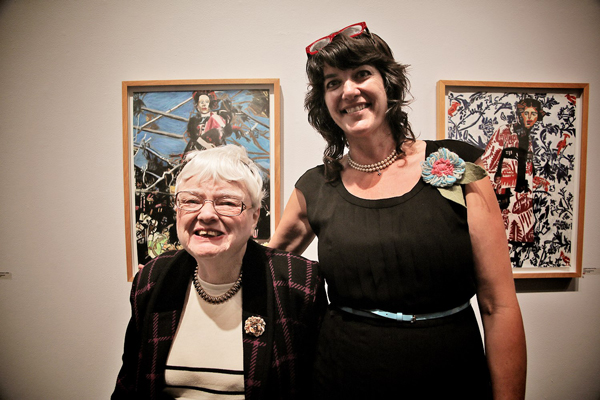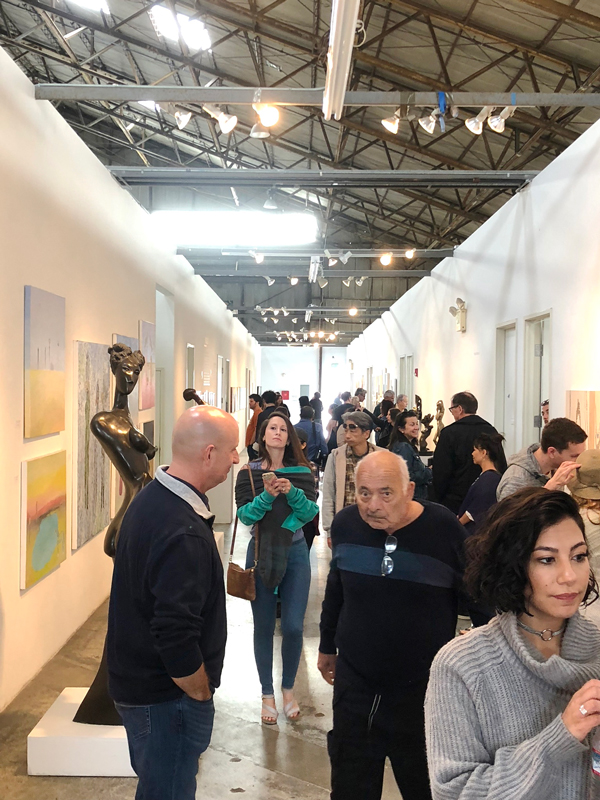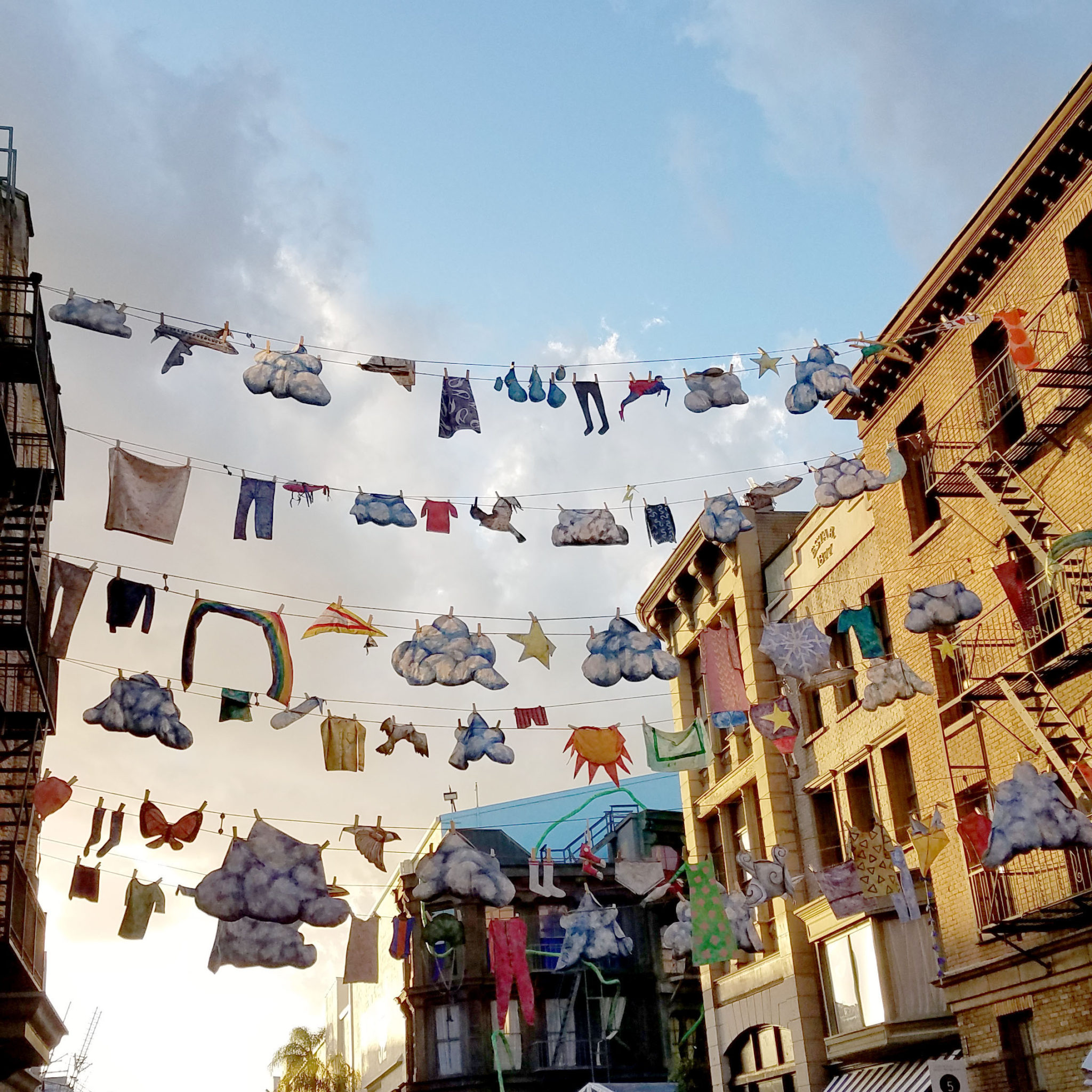NEW FAIRS IN TOWN, PART 2
 I don’t know about you, but Yours Truly is still recovering from our robust art fair season, when for one weekend in February we had five fairs bubbling up around the city. Seeing wonderful work was bliss, driving through traffic in the rain was hell. The most anticipated Frieze LA (Feb. 15–17) proved a hit—there were capacity crowds (about 30,000), with tix for the combined gallery and backlot adventure at Paramount sold out weeks in advance, and the backlot with its special installations and performances sold out by Saturday. Kudos to Frieze for a thoroughly well-planned visitor experience—shuttles from parking ran regularly; the tent featuring 70 galleries was crisp and well-lit; umbrellas were provided when it rained; and there was very good food and drink, and even nice pottery to purchase at the High Desert Test Sites booth.
I don’t know about you, but Yours Truly is still recovering from our robust art fair season, when for one weekend in February we had five fairs bubbling up around the city. Seeing wonderful work was bliss, driving through traffic in the rain was hell. The most anticipated Frieze LA (Feb. 15–17) proved a hit—there were capacity crowds (about 30,000), with tix for the combined gallery and backlot adventure at Paramount sold out weeks in advance, and the backlot with its special installations and performances sold out by Saturday. Kudos to Frieze for a thoroughly well-planned visitor experience—shuttles from parking ran regularly; the tent featuring 70 galleries was crisp and well-lit; umbrellas were provided when it rained; and there was very good food and drink, and even nice pottery to purchase at the High Desert Test Sites booth.
Art sales were apparently strong, also, with four works sold for over $1 million—including Mike Kelley’s Unisex Love Nest for $1.8 million at Hauser & Wirth and Yayoi Kusama’s Infinity Nets (B-A-Y) (2001) for $1.6 million at Lévy Gorvy. Gajin Fujita’s postmodern take on Japanese silkscreen prints, done as paintings and prints with contempo themes and tagging, nearly sold out at L.A. Louver. Not bad.
Yours Truly went twice, spending more time browsing the galleries one day, then more time in the backlot the other. There were many highlights—the fair drew New York heavy-hitters David Zwirner and Jack Shainman, as well as 10 younger galleries like Commonwealth & Council and Anat Ebgi who got in at reduced rates. Especially witty and arresting was a little shrine of Kim Dingle’s work at Susanne Vielmetter. It paired old work—two John Wayne ceramic heads that doubled as flower vases—with new work in which Dingle does paint-by-the-section on chipboard from Home Depot. Sometimes the pairing of low art with high art works.

Inside Tom Pope’s “One Square Club” in Frieze LA’s backlot, billed as the smallest bar in the world, one meter square.
Kudos to Ali Subotnick, who curated the excellent special art projects. High and Dry, Hannah Greely’s inspired installation of faux clothing hung on lines between faux tenement buildings in the backlot, was clearly the most Instagrammed artwork of the fair. Tom Pope’s very amusing “One Square Club” was billed as the smallest bar in the world, and I was fortunate enough to gain admission. Yes, I did have to wait in line in the freezing cold, but it was worth it. I was in the final trio to go through the bright orange door and meet Tom himself, bartending for us for eight minutes or so, and chatting brightly, or as brightly as he could after a long weekend of entertaining 400 strangers. “What did you get out of art school?” I asked (I’d read his bio while waiting; he went to the Royal College of Art). “Well,” he answered, with unexpected presence of mind, “the usual stuff, but maybe most important were the people I met, the friends I made.”

Hannah Greely’s High and Dry, at Frieze LA backlot, photo by Darren Kinney.
That same weekend a new fair popped up not far away from Frieze, and that was Felix, the brainchild of collector Dean Valentine and the Morán brothers, Al and Mills. It was located on an upper floor of the Hollywood Roosevelt Hotel, plus rooms around the pool. While it was tight navigating the narrow corridors, the fair was a delight, with both local and out of town galleries (several from New York, it seems to me) arriving to do business. There were two especially memorable booths: Thomas Solomon Art Advisory featured the high-color patterned work of Kim MacConnel, including paintings and painted armchairs which we were allowed to sit in, and which I wish I had room for chez moi. Baik Khneysser featured several contemporary Indonesian artists in a poolside suite.
:
LACMA LAMENTATIONS
On April 8 the LA County Board of Supervisors voted to approve LACMA’s $650 million dollar redo— knocking down four buildings, including three from the original William L. Pereira plan, and erecting Peter Zumthor’s giant coffee table which is designed to straddle Wilshire Boulevard. Much controversy was stirred when a final report revealed that the museum would actually be losing space rather than gaining as previously promoted— LACMA will lose about 9%, forcing curators and services to move to a rented spaces. The updated design does improve on the initial all-black one that I thought completely unsuitable for SoCal (not very good in our climate, museum director Michael Govan now admits)—it has been mellowed into what looks in renderings to be light gray.

Rendering of LACMA’s/Zumthor “Incredible Shrinking Museum”
On April 2 LA Times’ critic Christopher Knight’s call to arms was entitled “LACMA, the Incredible Shrinking Museum: A critic’s lament.” Govan’s response in a separate LAT interview was to say they would be creating satellite museums. Fact is, satellite museums tend to drain the coffer— in February, MOCA LA finally gave up on its Pacific Design Center satellite. More than once I have enjoyed perambulating its echoing .galleries as the solo visitor. And we do already have plenty of small museums—which are run locally. Knight also pointed out in an April 8 article that the costs per square foot wildly exceed that of The Broad and SFMOMA, opened not long ago. A very detailed critique is offered by critic/architect Joseph Giovannini in the LA Review of Books—https://lareviewofbooks.org/article/lacma-suicide-by-architecture/.
For LACMA there are two more hurdles ahead. First, gaining the air rights for the Wilshire crossover from the City of LA. I think the antis will be out in force for that. Second, raising the rest of the money (the county is throwing in $117.5 million, there have been sizable donations for a total of $560 million raised/pledged) from the good people of this county.
:

Helen Rae and Paige Wery at The Good Luck Gallery (photo by The Good Luck Gallery)
FAREWELL, GOOD LUCK
Sad to say The Good Luck Gallery, which has specialized in self-taught or outsider art, will be closing after five years in Chinatown. Rent wasn’t the problem, says gallery founder and director Paige Wery (and previous Artillery publisher). “Five years is a long time for a gallery when you don’t have a backer,” she said in a phone interview. Her brick-and-mortar business will cease operations, but “the brand will continue; it will morph into an itinerant gallery. It just feels like I need to move on.”
Currently up at The Good Luck Gallery is an exhibition curated by jill moniz. “Breadth” (through May 5) is a response to LACMA’S “Outliers and American Vanguard Art.” It features work that exists outside labels and the “exclusionary institutional gaze.” There will be a closing show opening May 11 which ends May 26, with sculptures by Parris Patton.
:

Wall created by Krista Augius, photo by Bianca Collins/The Art Minion
Rent Hikes at Santa Monica Airport Threaten to Push Artists Out
By Bianca Collins
On a March Saturday, the Santa Monica Art Studios (SMAS) hangar bustled with thousands of visitors. SMAS opened its doors in 2004 and has since been the cultural epicenter of the Annual Airport Art Walk. The 22,500-square-foot venue provides affordable studio space for 35 working artists. It is also the home of Arena 1, a large gallery that has hosted hundreds of national and international exhibitions, educational events and fundraisers for SoCal schools and art organizations. Each fall the SMAS Open Studios invites the community into their place of inspiration and manifestation. This rich cultural site has been gratis for anyone with a desire to be a part of the art scene in Santa Monica.
The opportunity to buy directly from artists at SMAS provides an accessible entry point for collecting.
But much of this is about to change, thanks to actions recently taken by Santa Monica’s City Council.
In 2016, the City Council adopted an Airport Leasing Policy that disallowed sub-leasing. SMAS founder Yossi Govrin was told that was prohibited by the master-tenant lease he held, and because that lease agreement included operating arts programs onsite, he would need to apply to retain management control over the artistic community and programs he had built from dust.

SMAS Studios Event, photo by Bianca Collins/The Art Minion
Then, in 2017, the City informed Govrin that they were required to change the market rates for rent at the airport due to a Santa Monica City consent decree. An official memo from the airport director incorrectly stated the amount Govrin was paying for his lease, making it appear that Govrin was making a substantial profit by charging tenants “exorbitant” amounts. Govrin disputes the memo’s accuracy and accounting, and says he has proved that all funds were funneled back into SMAS operations.
New lease agreements with accompanying rent hikes were recently circulated to the artists, and they’re angry. Despite multiple site visits and meetings with city Cultural Affairs department reps, most rents will be much more than Govrin charged, severely threatening their ability to stay.
Krista Augius, a tenant for nine years, says her rent will rise 16 percent. The hike affects the smallest studios most. Some tenants say that Snapchat—a key player in transforming Venice into high-end Silicon Beach, will pay less than many artists for its new spaces at the airport, complete with insulation, heat and other amenities not offered in the hangar.
It would be a tragedy if the Santa Monica Art Studios meet the same fate as Bergamot Station due to similar city-mandated interventions effective this summer. The decision to award SMAS’ peer organization 18th Street Arts Center with the power of management is fraught with controversy, dividing the art community even more, and setting the groundwork for a cultural monopoly in Santa Monica.


